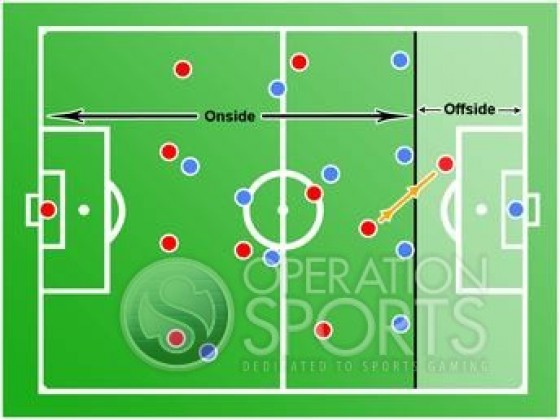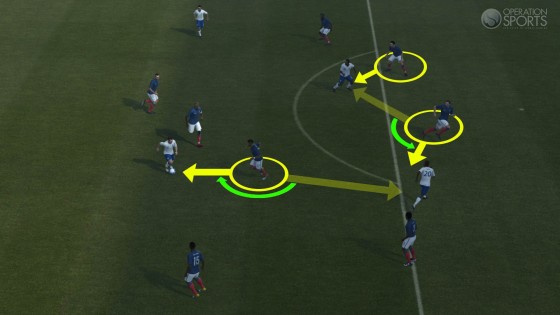

Ever played FIFA or PES and wondered just exactly why the ref blew the play dead? While most soccer rules are pretty easy to pick up, there are some peculiarities that can induce plenty of head scratching for a newcomer to the sport.
Offsides: The offside rule, especially with its new wrinkle in recent years, can be a little hard to come to grips with. Its intent is simple — to prevent cherry-pickers from standing in front of the opposition net the entire game. The very simplified version of the rule is that the attacking team’s player cannot occupy the space between the last defender and the goalkeeper before a pass is played. All is fair after the pass is hit, but before that the attacker has to time his run so that he is in line with that last defender. This is why you see those funky looking replays when they freeze frame the moment of the pass. Like this:

That little red dot on the far right is offside if that is where he is standing when the pass is played to him. If he is standing at the imaginary black line, or behind it, he would've been onside.
So far, so good, right? OK, now let’s throw in a few exceptions. First of all, there are no offsides on the following: Throw-ins, corners and goal kicks. So feel free to stand as close to the opposition goal as you like, but remember that if the ball reaches another player, the offside rule comes back into effect and your goalsuck may very likely be stranded. There are also no offsides if you intercept a backpass from the other team. So even if your player would've been technically miles offside, you are free to play on if the opposition gifts you the ball. Lastly, the offside rule is also negated if the ball is played within a team’s defensive half. This means that if your team’s striker is behind the opposition''s last defender, but is still within your own half when the pass is played, he is NOT offside. This is why teams, even when they really need to press for a goal, station their last defenders right on the halfway line and no higher, so opposition strikers cannot lurk behind them.
Still good? OK, one more. If a player is standing in an offside position, but isn’t “interfering with play”, the play continues. For example, a player is in an offside position on the right wing and the play is proceeding down the left flank. Since he is not involved in the action, the play goes on. If the action comes back to the right side, as long as he is onside again when the pass is played to him, it's fair game.
It probably takes some getting used to, but for purposes video gaming, all you really need to remember is to take one look at your striker before sending him that through pass. As long as he is not closer to the goalkeeper than the opposition's last defender, send away.
Cards: Fair or not, every sport has some way to really show its players who's the boss. Basketball has technicals, hockey has misconducts, and baseball has Joe West. Soccer? It's got cards... in two different colors!
A yellow card means caution, and a red, of course, means an immediate dismissal. Two yellow cards in the same game also adds up to in a red card — soccer’s version of math, or the color wheel, I suppose. Either way, that’s pretty easy to understand, the harder part is what gets you each color. Keep in mind that not all fouls necessitate a card, only those the refs deem cynical enough warrant one.
Like most things with the sport, there are way too many possibilities to cover this area even remotely comprehensively. So I’ll just list some examples that are most common within the video games. A yellow card is usually for a cynical challenge in which your player has pretty much no chance of winning the ball and you fly in for the challenge anyway. With FIFA 12's new push/pull module, repeatedly tugging on the ball carrier from behind may also earn you a yellow. A red card is given if one “denies a clear goalscoring opportunity”, which, in practical terms, usually means hacking a player down when he’s clean through on a breakaway. The ref can also hand out a red for dangerous challenges, like tackling another player from behind. But video game refs are usually more lenient, and your player will probably get a yellow instead. For the tackle happy, keep in mind that if you have more than four players sent off, you forfeit the match.
Advantages: Ever played PES and see that yellow icon with a man sticking his hands out like he's begging for food? That’s actually the sign for a referee “playing an advantage”. (FIFA refs play advantages too, but instead of a yellow icon, they've got Martin Tyler, in his smooth British voice, telling you.) If the official feels that letting play continue may be more beneficial to the team than a free kick, he can do exactly that in place of blowing the play dead. For example, if the opposition hacks your player down, but your player still manages to pass the ball up to the striker for a breakaway, the ref will play the advantage because your team is more likely to score with the breakaway than a free kick. The thing though is that if the team squanders possession after the advantage is given, they cannot get the free kick back.
You may see soccer as a sport with just two crucial elements — the players and the ball. But there is a third, and equally important facet: space. Think about it, to get the ball from one end of the pitch to another, potentially working your way through ten opposition players, is no easy feat. You can try dribbling through all of them, but you’re more likely to give yourself a really bad case of carpel tunnel than succeeding in FIFA or PES. So you try to pass the ball through them, but how? Advance the ball far enough and it’s likely you’ll feel like you’ve run into an imaginary brick wall.
The answer is to create space for your team. And how do you create space? Well, you can start at the moment you receive the ball. Two things: First, know where you want to go with it — not necessarily where you want to dribble the ball, it can also mean where you want the next phase of play to go to, through a sequence of passes. Second, check where the nearest defender is coming at you from. Then when you receive the ball, turn in a direction that hopefully brings you closer to setting up your next move, and also in a direction that will make the approaching defender change trajectory and lose momentum (usually a perpendicular angle to his initial path). Doing so will buy you some valuable time and space.
In the bigger picture, the best way to create space is to have teammates without the ball initiate runs. In video games, this can mean waiting for the AI to kick in and make them. Movement is the key to unlocking stubborn defenses and creating scoring opportunities. This is where the term “running into space” comes from.

Got the runs?
At the same time, don’t rush and take the first option available either. Just because your teammate makes a diagonal run doesn’t mean you should give it to him right away. Analyze the situation first, if you can. Sometimes that initial run may be better served as a decoy, dragging defenders away from another teammate in an even better position to receive the ball. Remember this the next time you feel stuck at the edge of the opposition’s penalty box. Be patient and try to look for seams opening up instead of quickly through balling it to the first player you see moving, and you’ll likely find yourself with much better options than you did before.
And what does this all mean in soccer video games? Well, PES, despite all its flaws, got its act together last year and smartened up its AI tremendously so it can read and react to offensive situations accordingly. You will likely to see many of your teammates drifting in and out of space, offering your ballplayer options. And while FIFA’s AI teammates’ also run when you expect them to, they can sometimes be runs of the unproductive variety, with AI players running into dead ends. However, as some of you may have read already, the devs are aiming to rectify this for FIFA 13, so we shall wait and see.
As much as I'd like to keep going, I'll leave it at that. There are, of course, much much more to soccer tactics that what's been covered here. With a large pitch and eleven players, the possibilities are vast when it comes to how to play the game. But if you're just starting out, you'd do well just to remember that, while attacking, space is your friend. If however you really want to learn all you can about tactical theories-- like how certain space is more valuable than others, asymmetrical formations, etc.-- Jonathan Wilson writes great in depth analysis for The Guardian and Michael Cox for Zonal Marking. Grab a cup of coffee before you start reading though, as their articles require your full attention and, perhaps, a few repeated readings in order to really appreciate the thought behind soccer tactics.
Check back for the final part of the guide, on a few matters of importance off the pitch!




 An Idiots Guide to Soccer and Soccer Gaming (Part II)
An Idiots Guide to Soccer and Soccer Gaming (Part II) OS Tip of the Day: The First Tricks Matter in SSX
OS Tip of the Day: The First Tricks Matter in SSX Madden NFL 12: Winning on Draft Day
Madden NFL 12: Winning on Draft Day AL West Team Strategy Guides
AL West Team Strategy Guides NHL 12: Role Players for Your Franchise
NHL 12: Role Players for Your Franchise